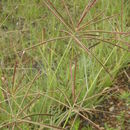Comprehensive Description
provided by North American Flora
Chloris submutica H.B.K. Nov. Gen. & Sp. 1: 167. 1816
Chloris polystachya Lag. Gen. & Sp. Nov. 4. 1816. (Type from Mexico.)
Chloris inermis Trin. Gram. Unifl. 232. 1824. (Based on Chloris polvslachya Lag.)
Eustachys polystachya Kunth, R6v. Gram. 1: 88. 1829. (Based on Chloris polystachya Lag.)
Chloris subbiflora Steud. Syn. Gram. 206. 1854.
j4gros(om(a mufj'ca Cerv. Naturaleza 1: 345. 1870. (Type from Mexico.)
Perennial, sparingly stoloniferous; culms 30-65 cm. tall, erect or decumbent at the base and rooting at the lower nodes, occasionally branching below; sheaths compressed-keeled, scabrous, the lower ones overlapping, the upper ones shorter than the internodes, more or less hispid at the throat; ligule 0.5 mm. long, membranaceous, minutely ciliate; spikes 5-14 (usually 8-10), 3-8 cm. long, more or less arranged in whorls on a short axis, spreading or reflexed, the rachis densely pubescent at the base; spikelets 3-3.5 mm. long, crowded; glumes acute, 1-nerved, scabrous on the keel, the first 1.3-2 mm. long, the second 2.3-3 mm. long, broader than the first; fertile floret 3-3.4 mm. long, the callus bearded, the lemma obtuse, the margins shortly pilose toward the tip, awnless or mucronate; rudiment about 2 mm. long, 0.5 mm. wide, truncate, awnless.
Type locality: Laguna de Tezcuco, Mexico {Humboldt &■ Bonpland). Distribution: Open ground and waste places, central Mexico.
- bibliographic citation
- Albert Spear Hitchcock, Jason Richard Swallen, Agnes Chase. 1939. (POALES); POACEAE (pars). North American flora. vol 17(8). New York Botanical Garden, New York, NY
Physical Description
provided by USDA PLANTS text
Perennials, Terrestrial, not aquatic, Stolons or runner s present, Stems nodes swollen or brittle, Stems erect or ascending, Stems caespitose, tufted, or clustered, Stems terete, round in cross section, or polygonal, Stem internodes solid or spongy, Stems with inflorescence less than 1 m tall, Stems, culms, or scapes exceeding basal leaves, Leaves mostly cauline, Leaves conspicuously 2-ranked, distichous, Leaves sheathing at base, Leaf sheath mostly open, or loose, Leaf sheath smooth, glabrous, Leaf sheath or blade keeled, Leaf sheath and blade differentiated, Leaf blades linear, Leaf blades 2-10 mm wide, Leaf blades mostly flat, Leaf blades mostly glabrous, Leaf blades scabrous, roughened, or wrinkled, Ligule present, Ligule a fringed, ciliate, or lobed membrane, Inflorescence terminal, Inflorescence solitary, with 1 spike, fascicle, glomerule, head, or cluster per stem or culm, Inflorescence a panicle with narrowly racemose or spicate branches, Inflorescence a panicle with digitately arranged spicate branches, Inflorescence wi th 2-10 branches, Inflorescence branches more than 10 to numerous, Inflorescence branches 1-sided, Lower panicle branches whorled, Inflorescence branches paired or digitate at a single node, Flowers bisexual, Spikelets sessile or subsessile, Spikelets laterally compressed, Spikelet less than 3 mm wide, Spikelets with 1 fertile floret, Spikelets with 2 florets, Spikelet with one perfect floret and one staminate floret, Spikelets solitary at rachis nodes, Spikelets all alike and fertille, Spikelets bisexual, Spikelets disarticulating above the glumes, glumes persistent, Spikelets disarticulating beneath or between the florets, Rachilla or pedicel glabrous, Glumes present, empty bracts, Glumes 2 clearly present, Glumes distinctly unequal, Glumes shorter than adjacent lemma, Glumes keeled or winged, Glumes 1 nerved, Lemma similar in texture to glumes, Lemma 3 nerved, Lemma apex truncate, rounded, or obtuse, Lemma awnless, Lemma mucronate, very shortly beaked or awned, less than 1-2 mm, Lemma margins thin, lying flat, Lemma straight, Palea present, well developed, Palea shorter than lemma, Palea 2 nerved or 2 keeled, Stamens 3, Styles 2-fid, deeply 2-branched, Stigmas 2, Fruit - caryopsis, Caryopsis ellipsoid, longitudinally grooved, hilum long-linear.

